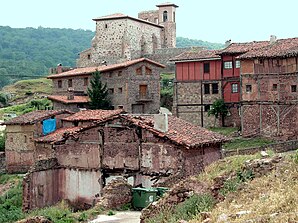Pinillos (La Rioja)
| Pinillos municipality | ||
|---|---|---|
 Pinillos - the townscape
|
||
| coat of arms | Map of Spain | |
 Help on coat of arms |
|
|
| Basic data | ||
| Autonomous Community : |
|
|
| Province : | La Rioja | |
| Comarca : | Tierra de Cameros | |
| Coordinates | 42 ° 12 ′ N , 2 ° 36 ′ W | |
| Height : | 1020 msnm | |
| Area : | 11.89 km² | |
| Residents : | 23 (Jan. 1, 2019) | |
| Population density : | 1.93 inhabitants / km² | |
| Postal code : | 26111 | |
| Municipality number ( INE ): | 26115 | |
| administration | ||
| Website : | Pinillos | |
Pinillos is a mountain town and a municipality ( municipio ) belonging to the poorly populated region of the Serranía Celtibérica with only 23 permanent residents (as of January 1, 2019) in the autonomous community of La Rioja in northern Spain .
Location and climate
The place Pinillos is located in a side valley of the Río Iregua a good 40 km (driving distance) southwest of the provincial capital Logroño at an altitude of approx. 1020 m . The climate is temperate to warm; Rain (approx. 640 mm / year) falls mainly in the winter months.
Population development
| year | 1857 | 1900 | 1950 | 1995 | 2018 |
| Residents | 147 | 147 | 81 | 31 | 15th |
As a result of the mechanization of agriculture , the abandonment of small farms and the resulting lower demand for labor, the number of inhabitants has declined significantly since the beginning of the 20th century.
economy
For centuries, the community was oriented towards agriculture for the purpose of self-sufficiency , with livestock farming (milk, cheese, meat) in the foreground. In addition, clothes were made from the sheep's wool. Today, holiday apartments or houses (casas rurales) are rented out, especially in the summer months .
history
Celtiberian , Roman , Visigoth and even Islamic-Moorish traces of settlement were not discovered in the municipality. The high-lying area served as summer pasture for sheep and goats for centuries . A military reconquest ( reconquista ) by the Christians did not take place, but the place was gradually settled as part of the Repoblación . In the Middle Ages the region was disputed between the kingdoms of Castile and the kingdom of Navarre ; the territory of the Tierra de Cameros belonged temporarily to the Lara family . In 1366, the Castilian King Henry of Trastamara handed over 40 villages in the Tierra de Cameros area to his faithful Juan de Arellano, whose successors, the Condes de Águilar and the Duques de Abrantes , remained the landlords (señores) of the area for a long time . After the abolition of all manorial lords in 1811, Pinillos came to the province of Soria and in 1822 to the newly created province of Logroño , from which the La Rioja region later emerged.
Attractions
- The Iglesia de la Asunción , which is located on a hill and mostly made of poorly hewn stone (mampostería) , is dedicated to the Assumption of Mary and dates from the 16th century. It has a (disused) two-part bell gable (espadaña) and an additional bell tower (campanarrio) that was added in the 18th century .
- The older houses in the village are made of quarry stones, but often have structures made of half-timbered buildings with clay fillings .
- The Ermita del Santo Cristo stands on a mountain slope in the village.
- Surroundings
- The ruins of the Ermita de San Roque are about 2 km outside the village.
Web links
- Pinillos - photos + short information (spanish)
- Pinillos - photos + short information (wikirioja, Spanish)
- Pinillos - photos + short information (spanish)
- Pinillos, history etc. - information (Spanish)
Individual evidence
- ↑ Cifras oficiales de población resultantes de la revisión del Padrón municipal a 1 de enero . Population statistics from the Instituto Nacional de Estadística (population update).
- ↑ Pinillos - climate tables
- ↑ Pinillos - population development
- ↑ Pinillos - Church
- ↑ Pinillos - Ermita des Santo Cristo
- ↑ Pinillos - Ermita de San Roque

